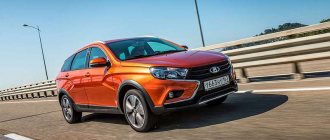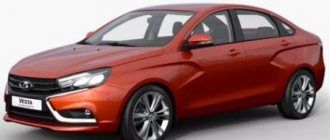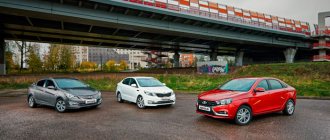Almost simultaneously, there were two more elevated passenger cars on the Russian market. AVTOVAZ launched the long-awaited Vesta SW Cross, and Kia responded with a special configuration of the Rio hatchback with the X-Line prefix. The starting price of a domestic car is 755,900 rubles; for a “Korean” they ask from 774,900 rubles. The cost makes it clear that these newcomers are direct competitors. Which one you prefer depends on what car parameters are important to you.
|
Kia Rio X-Line |
Adaptability to bad roads
On off-road terrain, the Lada Vesta SW Cross will give a Korean car a run for its money. According to the official specifications, the lowest point of its body is 203 mm from the ground, while the Kia's ground clearance is only 170 mm. This is even less than stated for regular Vests (178 mm), but by passenger standards the figure is not bad. Considering that Vesta’s wheelbase is only 35 mm longer than that of the Rio X-Line (2635 versus 2600 mm), from the point of view of geometric cross-country ability, Lada looks like a more correct option.
Vesta has ground clearance of 203 mm versus 170 mm for Rio. But the Kia is equipped with more practical high-profile tires.
Vesta has ground clearance of 203 mm versus 170 mm for Rio. But the Kia is equipped with more practical high-profile tires.
Capacity
The Lada Vesta SW Cross is larger than the Korean car: 4424 mm in length and 1785 mm in width versus 4240 and 1750 mm, respectively. And Vesta’s wheelbase is a little longer, as we have already found out. That’s why the Lada passengers will have a little more space.
As for the luggage compartment, it is obvious that the station wagon has more room than the hatchback of the same class. We haven’t had time to measure the Rio X-Line’s trunk volume yet, so we’ll rely on factory data. The manufacturer promises 390 hp. Vesta claims much more - 480 hp. Both indicators are given based on loading “under the curtain”. In the Lada, the volume of the cargo compartment is limited by the littered rear pillars, but it still surpasses the Kia in terms of maximum capacity. So if you plan to frequently load your car to capacity, Vesta SW Cross is your choice.
The domestic model loses in terms of the maximum level of safety: it has only four airbags. But they are already provided in the “base”, while Kia will have only two pillows, if you are not ready to pay at least 965 thousand rubles for one of the top versions.
The domestic model loses in terms of the maximum level of safety: it has only four airbags. But they are already provided in the “base”, while Kia will have only two pillows, if you are not ready to pay at least 965 thousand rubles for one of the top versions.
Interior
If we do not consider the issue of configurations, and simply evaluate the interior of both cars, then we can admit that the KIA Rio X Line is better than the Lada Vesta SV Cross, although there is still no overwhelming advantage.
KIA pleases with the quality of its work. The plastic is inexpensive, but you can’t fault the build quality, and its texture is very pleasant. The ergonomics are well thought out, especially the dashboard, which looks good and is easy to read, and the keys are pleasant to the touch. The interface of the multimedia system is simple and clear.
We are pleased with the well-organized central tunnel with a pair of cup holders, a place for a smartphone and a spacious niche right next to the center console.
The seats are soft, although there is no lumbar support. The rear sofa is very cozy, but a little small, and therefore you will have to make room a little in the gallery. The trunk in its normal position is so-so, but with the rear seat folded down it will give Vesta a head start. Visibility is also disappointing, although the A-pillars are not too wide. The picture is spoiled by small mirrors and a narrow rear window.
As for the interior of the Lada Vesta SV Cross, it outperforms its competitor in some respects. In particular, there is lumbar support in the seats, the mirrors are noticeably larger, and the seating geometry is comfortable. The second row is significantly more spacious than in the X-Line, and the trunk is larger, although when unfolded it is still inferior to its counterpart.
But there are also shortcomings. This concerns, first of all, the quality of materials and workmanship. Of course, SV Cross is a big step forward, but it still falls short of KIA. There are some annoying miscalculations in ergonomics - it’s inconvenient to fasten seat belts due to the fact that the lock is too recessed, the front seat headrests protrude too far forward, and controlling the on-board computer and multimedia is also not the easiest.
The glove box lid is equipped with a microlift, but it works so-so, the steering column switches are clumsy. Well, the power window unit, borrowed from Granta, looks completely miserable.
Engine and gearbox
The Koreans did not highlight the interior of the pseudo-crossover with any decor. The most expensive configuration includes eco-leather trim. A dubious advantage, given the quality of this material.
The Koreans did not highlight the interior of the pseudo-crossover with any decor. The most expensive configuration includes eco-leather trim. A dubious advantage, given the quality of this material.
Vesta flaunts dynamic markings in the image from the rear view camera. Rio responds with two options for the multimedia system. One has its own navigation, the other can only broadcast it from the screen of the owner’s smartphone.
Vesta flaunts dynamic markings in the image from the rear view camera. Rio responds with two options for the multimedia system. One has its own navigation, the other can only broadcast it from the screen of the owner’s smartphone.
All versions of the Kia Rio X-Line have a warm steering wheel. Perhaps in the future this option will appear in Lada.
All versions of the Kia Rio X-Line have a warm steering wheel. Perhaps in the future this option will appear in Lada.
Kia offers a choice of two petrol engines for its lifted hatchback, with a power of 100 and 123 hp. The Lada engine line includes comparable units of 106 and 122 hp. So there is parity in power. As well as in terms of acceleration dynamics. The “Korean” covers the first 100 km/h in 10.7–13.4 seconds, depending on the power unit. Lada - in 11.2–13.3 seconds. Both cars allow the use of AI-92 gasoline, but Kia is more economical. Fuel consumption for the Rio X-Line in the combined cycle varies from 5.9 to 6.8 l/100 km, while for the Lada it ranges from 7.5 to 7.9 l/100 km. Of course, real figures will differ from those stated, but official measurements were carried out using a single methodology, so we have the right to compare them.
The Koreans offer a modern 6-speed automatic transmission as an option, for both engines. The domestic car has only a robot with one clutch, which only the laziest would not kick for slowness. Moreover, it is available exclusively in combination with a 122-horsepower engine. So for fans of a comfortable and at the same time dynamic ride, Lada can only offer a manual version.
|
A rear folding armrest with a pair of cup holders is an attribute of Vesta with the Prestige package. Kia doesn't have that. |
Heated rear seats have become the norm for B-class budget employees. Both cars are equipped with it in the two most expensive trim levels. | |
Lada Vesta Cross or X Ray: comparison of cars
First, let's evaluate the sales level of these models. Since Vesta in the “Cross” version was launched on sale quite recently, we will take sales of regular Vesta sedans and station wagons and compare them with the X-Ray indicators. There is the following data:
- a year after the start of production, the number of Lada Vesta station wagon cars sold reached 8,000;
- Lada is ahead of its competitors in terms of total sales of passenger cars;
- from January to August 2021, Vesta was the second most popular car after the Kia Rio, while the X-ray was only in 9th place. These are the total figures for the Vesta model, including the sedan and station wagon.
The statistics are already giving us pause. On the other hand, these data reflect not so much the quality of the cars sold, but the preferences of the car enthusiasts themselves and their purchasing power.
The average price for Vesta in the Cross version is about 788,900 rubles, while XRay will cost almost 100 thousand cheaper.
And if everything is clear with popularity, then from a price point of view the advantage is clearly not in favor of the Lada Vesta.
Comparison of dimensions and appearance
The cars are built on different chassis. In the case of X-Ray, this is the B0 platform, on which popular models of the Renault-Nissan concern are built. But Vesta has a completely original chassis design.
Body and dimensions
Externally, Lada Vesta and X-Ray are so similar that if it were not for the difference in height and body shape, one could confuse them even if they were placed next to each other. They have one thing in common: design at the level of modern foreign cars and the famous “X-DNA”.
This is interesting: Rating of the best Chinese crossovers - how to choose a new car from China
Vesta Cross is a sedan, while the X-Ray is a hatchback. Vesta Cross is slightly lower and longer than the X-ray (4424 millimeters in length versus 4165 for the hatchback) and visually this gives it a more rapid appearance.
Dimensions of Lada Vesta Cross
Vesta Cross station wagon (Lada Vesta SW Cross) has the same dimensions as the sedan, with the exception of height - SW Cross has become 11 mm higher.
Dimensions of Lada Vesta SV Cross
Externally, Iksray gives the impression of a more “muscular” comrade - a small “jock” of the domestic automobile industry, taller and shorter than the elegant Vesta Cross.
Dimensions of Lada XRAY
Where the Vesta Cross modification definitely wins externally is in ground (203 millimeters versus 195 for its competitor). It's a small difference, but there are situations in which even a small advantage can be significant. Russian roads in a number of regions prove this truth every day. At the same time, do not forget that a loaded car loses 2-3 cm of ground clearance.
Lada X-Ray stands out from its competitor with a high window sill line, visually making the car somehow more powerful. “Compact high hatchback” is how it is officially called, and the Lada X-Ray fully justifies this name.
After just a couple of years of launching into the series, the Lada Xray has already completely fit into everyday reality, is selling well (see statistics at the beginning of the article) and has found constantly warring armies of fans and haters on the Internet.
The fact is that AvtoVAZ wanted to stuff a newly designed body into the base from Renault Sandero Stepway. The result was controversial.
The dimensions of the VAZ Xray are almost identical to the Sandero, including the length of the body and the size of the wheelbase. Even the head optics are very similar to those installed on the Stepan. But despite its continuity, the new Lada has become a market bestseller, although not as popular as Vesta.
The XRay body turned out to be truly original in appearance, although the Sandero is considered a more status model by the group. Partly because the basic version has only 15-inch wheels, and only higher trim levels can afford 16- or 17-inch ones.
Xray is the result of a compromise integration of a new body into a chassis that has long been mastered on the assembly line. Questions may arise here regarding the passive protection of passengers, since the car has not passed the EuroNCAP tests. But many were most disappointed by how the production hatchback looks compared to the concept.
This is the production car:
And this is the design prototype:
Agree that the car has lost most of its charm. All that remains is the notorious letter X in the front part and on the side stampings. But the result was at least a repairable design. Just ask yourself: could the manufacturing plant change assembly equipment and retrain staff in a short time? That's it...
Salon
In the interior of the Vesta Cross, the ergonomics of the front panel make a pleasant impression. A serious drawback is the inability to display speed information on the on-board computer display, since the analog instrument scales are difficult to read during the day.
But in general, the interior is put together so well that even the plastic trim does not make any squeaks. Noise insulation, as already noted by many reviewers, is better than in the XRay, and is already ahead of that of the concern's previous budget models. Even at a speed of about 130 km/h, you can carry on a conversation (although at such speeds it is better not to be distracted by chatter).
Vesta Cross salon:
Now let's take a look at the ergonomics and equipment of the Lada XRay. Like the exterior, the interior environment doesn't look as great as the 2012 prototype. Compared to Vesta Cross here:
- no central armrest,
- many control buttons are inconvenient (heating, for example) and you still need to reach them,
- the required antifreeze temperature indicator is missing on the dashboard of the XRay hatchback,
- unsatisfactory visibility through the central rearview mirror and generally from behind, since the window behind is too small.
The common problem of both cars is that the multimedia system is not very fast and the navigation is not the most advanced.
Three adult passengers can fit relatively comfortably behind the driver. “Relatively” - because the ergonomics of the rear seats are not conducive to long trips. And even in the maximum configuration, there is no longitudinal adjustment of the sofa and is not expected.
And how did it happen that the trunk of the XRAY is smaller than that of the Vesta?
Overall: alas, Xray loses to Vesta in terms of visibility and interior ergonomics. Although it’s worth mentioning about Vesta’s armrest that it interferes with using the handbrake. It would be better if it were movable.
Ride and Handling
The Vesta Cross sedan has the same chassis as the previous SW Cross station wagon and, apart from the body type, there are no significant differences. Their main units are identical, even many body parts are compatible. There is a difference in the suspension design (springs, shock absorbers), and in the bifurcated muffler and plastic body kit, which cannot be installed on a regular Vesta sedan.
The difference in price between just a Lada Vesta and Vesta with the Cross prefix, depending on the version, is 53 – 63 thousand rubles. If you choose between a “cross” sedan and a station wagon, then the cost of the latter will be 32 thousand more expensive - this is a standard surcharge for the two-volume body of the Vesta.
Transmission Lada Vesta and X-Ray
Neither Vesta Cross nor XRAY differ from each other in their set of engines and gearboxes. But the hatchback has more trim levels and the price for the initial version is 579,900 rubles versus 763,900 for Vesta. However, the sedan has better handling and acceleration dynamics. But there are controversial points : Vesta Cross drives normally on the highway, but in traffic jams there is a noticeable lack of traction at the “lower levels”.
The top version of XRAY has a trump card hidden up its sleeve - “robot”! It is he who helps where it is difficult to travel. However, sometimes it is inadequate in choosing driving modes, so most owners prefer “mechanics”: nerves are more expensive.
The transmission of the Vesta Cross sedan is slightly different from that found on station wagons. According to the manufacturer, the robotic gearbox of the top-end Vesta now changes gears faster. True, journalists who could tell about the updated “robot” AMT 2.0 never got it. In this regard, you’ll have to take the marketers’ word for it... But no one has any complaints about the “mechanics”. probably a draw in this round between Cross and XRAY.
Available engines and fuel consumption
For both cars, engines with a displacement of 1.6 and 1.8 liters, with a power of 106 and 122 hp, of domestic production are available. It is worth mentioning separately the Japanese motor for the XRAY, which is currently no longer installed on it , since it is more expensive and more difficult to maintain. As for the VAZ 1.8-liter engine under the symbol VAZ-21179, it is, in fact, experimental and there are complaints about it. There is an opinion that its 122 “horses” are not enough for country roads, so overtaking must be done with careful calculation, as if you were a racer. The tachometer cutoff occurs earlier than expected.
However, within the city the dynamics of the 1.8-liter unit are sufficient. But real fuel consumption is controversial: it never drops below 8 liters per “hundred” . But here Vesta and XRAY maintain parity: the engines are the same! Moreover, Vesta is definitely capable of driving 700 km on a full tank without refueling, but under conditions: on good roads and with high-quality gasoline. Speaking of fuel, there are differences: Vesta needs 92 gasoline, while XRAY uses AI-95. Taking into account current fuel prices, this can play a decisive role in the choice between the cars under review. But there is a mitigating point here - after upgrading the VAZ-21129 engine, the use of AI-92 is also allowed.
There is no point in even comparing them in terms of speed: both cars are designed for relatively quiet driving. These are not sports sedans, but rather cars for travelers (with a stretch) and for family people (the latter applies more to the XRAY).
Suspension and handling
The Vesta Cross sedan's ride turned out to be worse than that of conventional sedans - the stiffer suspension and 17-inch wheels with low-profile tires (205/50 R17) are to blame.
But the car turns confidently and without rolls. And no road bumps can throw Vesta off course (which cannot be said about the oncoming air currents from oncoming trucks on country highways).
In terms of handling, Vesta is more playful than Xray, which especially helps on unpaved sections of the road and off-road. The steering wheel responds to even the slightest movement.











